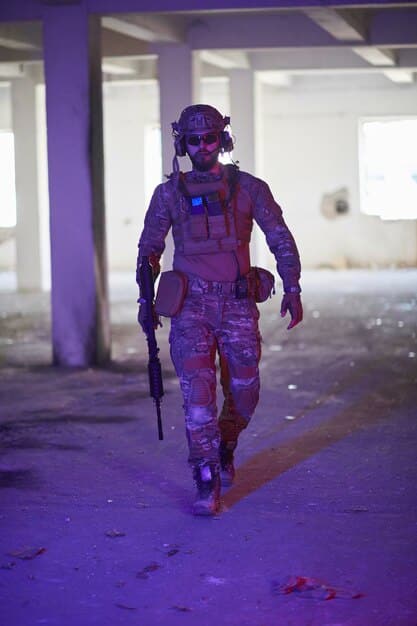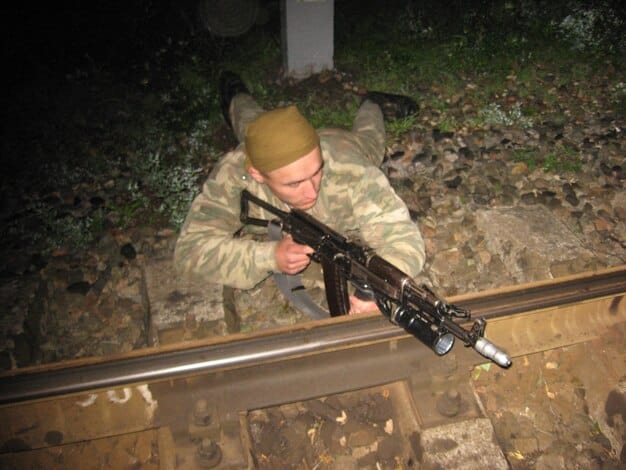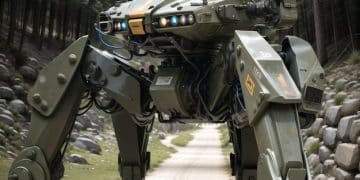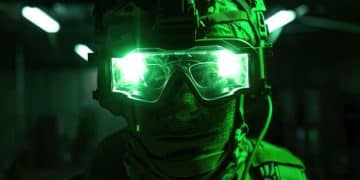Army’s Next-Gen Squad Weapon: CQC Impact by 2025

The U.S. Army’s Next-Generation Squad Weapon (NGSW) is poised to fundamentally alter close quarters combat tactics by 2025 through superior lethality, extended range, and enhanced precision, demanding significant shifts in soldier training and operational doctrine.
The landscape of modern warfare is in constant flux, driven by technological advancements that reshape how engagements unfold. One such pivotal development, the U.S. Army’s Next-Generation Squad Weapon (NGSW), is set to profoundly influence military strategies. The question of how will the Army’s Next-Gen Squad Weapon impact Close Quarters Combat Tactics by 2025 is not merely academic; it delves into the practical realities faced by soldiers on the ground.
Understanding the Next-Generation Squad Weapon (NGSW) Program
The NGSW program represents a significant leap forward in small arms technology, aimed at replacing the M4 Carbine and M249 Squad Automatic Weapon. This initiative seeks to provide soldiers with a substantial overmatch capability against near-peer adversaries, particularly in terms of range, lethality, and precise target engagement. The development process has been rigorous, involving extensive testing and refinement of prototypes from various defense contractors.
The core objective behind the NGSW, including both the XM7 Rifle (replacing the M4) and the XM250 Automatic Rifle (replacing the M249), is to address the evolving threats on the modern battlefield. Traditional 5.56mm ammunition has demonstrated limitations against advanced body armors at extended ranges, necessitating a new caliber and weapon system. The chosen 6.8mm cartridge promises superior ballistic performance, increased muzzle velocity, and enhanced terminal effects.
Key Features of the NGSW System
Beyond the caliber change, the NGSW weapon systems incorporate a suite of advanced features designed to maximize soldier effectiveness. These include integrated fire control systems, advanced optics, and improved ergonomics. The aim is to create a more intuitive and lethal weapon platform.
- Enhanced Precision: The integrated fire control system on the XM7 and XM250 will feature ballistics calculators and environmental sensors, offering highly accurate point-of-aim adjustments designed to improve soldier first-round hit probability, especially at longer ranges under stress.
- Superior Lethality: The new 6.8mm ammunition provides greater penetration capabilities against modern body armor and increased kinetic energy on target, translating to a more decisive impact during engagements.
- Reduced Recoil and Improved Ergonomics: Despite the more powerful cartridge, engineering efforts focus on managing recoil and improving the weapon’s balance and handling, making it more controllable in rapid-fire scenarios common in CQB.
The transition from a 5.56mm to a 6.8mm caliber is not just about raw power; it’s about optimizing the entire soldier-weapon system for future conflicts. The increased range and penetration capability of the NGSW will significantly extend the effective engagement envelope for the individual soldier. This evolution means that in environments where engagement distances were previously limited, soldiers will now possess the means to dictate terms from further away, influencing how they approach and secure objectives. The implications for close quarters combat are profound, as even in confined spaces, the weapon’s inherent capabilities become a significant force multiplier.
Transforming Close Quarters Combat Paradigms
Close Quarters Combat (CQC) is characterized by engagements that occur at very short distances, often within buildings, urban environments, or dense terrain. Speed, precision, and overwhelming fire superiority are paramount. The introduction of the NGSW is poised to recalibrate these foundational elements. The enhanced lethality of the 6.8mm rounds means that engagements, when they do occur, could be more decisive, potentially reducing the number of rounds required to neutralize a threat. This has ramifications for ammunition loadout, logistical considerations, and the pace of operations.
Increased Lethality and Its Immediate Impact
The 6.8mm ammunition developed for the NGSW delivers a significantly greater kinetic energy transfer than current 5.56mm rounds, alongside improved armor penetration. In CQC, where targets may be heavily armored or partially obscured, this heightened lethality translates to a higher probability of incapacitating direct threats. This immediate impact will compel soldiers to rethink their engagement techniques, potentially favoring precision over volume of fire in certain scenarios, although suppression will remain a critical component.
Traditionally, CQC emphasizes rapid, multiple-shot engagements to ensure target neutralization. With the NGSW, the potential for “one-shot-stop” capability against a wider range of threats might alter this paradigm. This doesn’t mean soldiers will fire fewer rounds overall, but rather that the effectiveness of each round fired is substantially increased. This efficiency can be critical in chaotic, high-stress close-quarters environments where every second and every round counts.
Precision Fire and Target Discrimination
The advanced fire control system, integrated with the NGSW, offers capabilities far beyond traditional iron sights or unassisted optics. This system provides real-time ballistic solutions, adjusting for range, wind, and even lead on moving targets. While seemingly more relevant for longer ranges, its application in CQC is equally transformative. Rapid target acquisition and improved precision, even at extremely close distances, become possible. The system can aid in distinguishing between threats and non-combatants in cluttered environments, a critical aspect of rules of engagement and avoiding collateral damage.
For soldiers operating in complex urban terrain, where threats can emerge from any direction and civilian presence is often unavoidable, the NGSW’s precision capabilities offer a crucial advantage. The ability to place effective fire precisely on a fleeting target reduces the risk of over-penetration or missed shots that could endanger friendly forces or bystanders. This heightened precision will necessitate refined training protocols focusing on rapid decision-making and optimal use of the advanced optics.
Tactical Adaptations and Doctrinal Shifts
The Army’s tactical doctrine for CQC is built around speed, violence of action, and effective room clearing procedures. The NGSW will inevitably lead to adaptations in these established methodologies. Squads will need to reassess how they enter and clear spaces, considering the new weapon’s capabilities. The balance between suppressive fire and precision targeting might shift, requiring new training emphasis.

Altered Engagement Distances and Breaching Strategies
While CQC implies short ranges, the enhanced penetration and effective range of the NGSW could subtly alter how assaults are initiated. Squads might be able to engage threats more effectively from slightly greater distances within a building or from adjoining structures before close contact. This could influence breaching strategies, potentially allowing for more flexibility in entry points or enabling overwatch from positions that were previously considered too far for effective engagement with standard small arms.
For instance, an entry team might use the NGSW’s capabilities to neutralize a threat partially visible through an opening from a more secure position, rather than having to fully commit to a high-risk immediate assault. This nuanced change in effective engagement distance, even within the confines of a building, opens up new avenues for tactical creativity and potentially reduces exposure to immediate danger. The breaching process itself might become more deliberate, as soldiers gain confidence in their ability to engage targets from varied stand-off distances.
Revised Fire and Movement Principles
Fire and movement are the bedrock of infantry tactics. In CQC, this often involves coordinated bursts of suppressive fire to allow teammates to advance. With the NGSW, the increased lethality may mean that fewer rounds are needed for effective suppression, or that suppressive fire can be delivered more precisely. This could free up individual soldiers to focus on other tasks, such as maneuver or target identification, rather than simply maintaining a high volume of fire.
The improved control and reduced felt recoil of the NGFW, even with its more powerful round, allows for faster follow-up shots and maintaining accuracy during rapid fire. This means that a soldier delivering suppressive fire might be able to transition more quickly to precision engagements. The coordination between team members, the timing of their movements, and the allocation of fire roles will therefore need to be re-evaluated to leverage these enhanced individual capabilities fully. This could lead to more dynamic and unpredictable room-clearing sequences, making it harder for adversaries to anticipate tactical moves.
Logistical and Training Implications
The introduction of any new weapon system of the NGSW’s magnitude carries significant logistical and training implications. The sheer volume of new ammunition, parts, and maintenance requirements will necessitate a robust supply chain adjustment. Furthermore, integrating new capabilities into soldier training demands comprehensive revisions of current programs. This transition isn’t just about handing out new rifles; it’s about fundamentally re-educating soldiers and leaders on how to maximize the system’s potential.
Ammunition Supply Chain and Weight Considerations
The 6.8mm ammunition is heavier than the 5.56mm, which will directly impact soldier loadout and logistical resupply. While the NGSW provides increased lethality, soldiers will likely carry fewer rounds for the same weight, potentially influencing CQC tactics by emphasizing more deliberate, controlled engagements rather than prolonged fire-fights. The Army will need to meticulously balance lethality with logistical feasibility, exploring innovative ways to resupply combat units in dynamic environments.
- Increased Round Weight: The heavier 6.8mm rounds mean soldiers might carry a reduced basic load, necessitating more efficient resupply methods and tactical ammunition management during sustained combat operations.
- Logistical Bottlenecks: Transitioning to a new caliber requires a complete overhaul of manufacturing, distribution, and storage, potentially creating temporary logistical challenges during the initial rollout phases.
- Vehicle Load Capacities: The increased weight per round will also impact the carrying capacity of vehicles transporting ammunition, requiring adjustments to convoy planning and combat resupply missions.
Moreover, the larger ammunition size and weight extend beyond individual soldier load. The entire supply chain, from the manufacturing plant to the forward operating base, will need to adapt. This might involve reconfiguring storage facilities, redesigning packing solutions, and upgrading transportation methods. The Army’s ability to seamlessly integrate such a change will be a key determinant of the NGSW’s overall operational success.
Revising Soldier Training Protocols
Current CQC training focuses on muscle memory and instinctive responses with existing weapon systems. The NGSW’s advanced features, particularly its integrated fire control, will demand a significant revision of these protocols. Soldiers will need training not just on weapon manipulation but on fully leveraging the nuanced capabilities of the intelligent optics and ballistics computers. This will likely involve more simulation-based training and advanced shooting drills that integrate real-time data interpretation.
The shift will move beyond simply hitting a target; it will involve understanding how the weapon system provides a dynamic aiming solution based on environmental factors and target movement. This level of integration requires a higher cognitive load during initial training but promises to yield more effective and precise engagements in real-world scenarios. Training will evolve to incorporate more complex decision-making drills under pressure, simulating the exact ambiguities of urban warfare.
Strategic Implications and Future Outlook
Beyond the immediate tactical and logistical considerations, the NGSW program carries significant strategic implications. It signals a clear commitment by the U.S. Army to maintain its technological edge against potential adversaries. The capabilities of the NGSW will influence how other nations develop their own small arms and counter-tactics, potentially spurring a new era of infantry weapon development globally. The program is not merely an incremental upgrade; it represents a foundational shift in how the individual soldier contributes to overall battlefield dominance.
Deterrence and Near-Peer Competition
The fielding of the NGSW sends a strong message to potential adversaries regarding the U.S. Army’s commitment to modernizing its forces. The ability of individual infantry squads to engage and neutralize threats at greater distances and with increased lethality serves as a potent deterrent. In a landscape of near-peer competition, where tactical advantages can be subtle but decisive, the NGSW provides a distinct competitive edge, particularly in congested and complex environments where precision matters.

This extends beyond direct engagement. The psychological impact on an adversary, knowing that U.S. forces possess a superior individual weapon system, can influence their willingness to engage or the tactics they employ. This acts as a form of “overmatch deterrence,” where the sheer capability of the U.S. soldier effectively alters the adversary’s calculus. This strategic advantage is particularly critical in scenarios where dismounted operations are central to achieving objectives, making the NGSW much more than just a new rifle.
Future Small Arms Development
The NGSW platform is likely to serve as a testbed for future innovations in small arms technology. The integration of advanced fire control, sensor fusion, and sophisticated ammunition designs will undoubtedly inform subsequent generations of infantry weapons. The lessons learned from the deployment and combat performance of the NGSW will be invaluable for the continued evolution of soldier lethality systems. This ripple effect could drive advancements across the military industry.
Areas such as power management for integrated optics, recoil mitigation techniques for high-energy rounds, and material science for lighter, more durable weapon components will all benefit from the NGSW’s development cycle. The program’s success or challenges will directly inform the research and development priorities for future small arms, ensuring that the U.S. Army maintains a technological lead in this crucial domain. The NGSW’s legacy will be seen not just in the weapons themselves but in the methodologies and technologies they inspire.
By 2025, the U.S. Army’s Next-Generation Squad Weapon is expected to be a significant force multiplier, fundamentally reshaping Close Quarters Combat tactics. Its enhanced lethality, precision, and range will compel shifts in how soldiers train, operate, and engage adversaries in confined spaces. This evolution represents a strategic investment in maintaining overmatch capability and ensuring the continued effectiveness of the dismounted soldier.
| Key Area | Impact on CQC by 2025 |
|---|---|
| 💥 Enhanced Lethality | More decisive engagements, potential for fewer rounds needed to neutralize targets, forcing a rethink on fire discipline. |
| 🔭 Advanced Precision | Integrated fire control aids rapid target acquisition and discrimination, reducing collateral risk in complex environments. |
| 🔄 Doctrinal Shifts | Revisions needed for room clearing, breaching, and fire & movement, adapting to the NGSW’s extended capabilities. |
| 📚 Training & Logistics | New training protocols required for advanced systems; 6.8mm ammunition necessitates supply chain and loadout adjustments. |
Frequently Asked Questions About NGSW and CQC
The primary objective is to replace the M4 Carbine and M249 Squad Automatic Weapon with a system that provides superior lethality, range, and precision. This upgrade aims to enhance overmatch capabilities against adversaries with advanced body armor and to improve battlefield effectiveness in various combat scenarios, including CQC.
The 6.8mm caliber offers increased kinetic energy and armor penetration, making engagements more decisive. While CQC is typically at short ranges, this lethality means threats can be neutralized more effectively, potentially altering the number of rounds required and the approach to target engagement in confined spaces.
Absolutely. The NGSW’s integrated fire control and advanced optics will necessitate significant revisions to CQC training protocols. Soldiers will need to learn how to effectively utilize these intelligent features for rapid target acquisition, improved precision, and advanced decision-making in dynamic, high-stress close-quarters environments.
The primary logistical challenge is the increased weight of the 6.8mm ammunition, which affects soldier loadout and resupply efforts. The Army must adapt its supply chain to accommodate the new caliber, ensuring continuous availability of ammunition without unduly burdening soldiers or logistical units during intense CQC engagements.
By 2025, the NGSW will significantly enhance the U.S. Army’s dismounted infantry capabilities, strengthening its overmatch against near-peer adversaries. This technological leap will serve as a strong deterrent and influence global small arms development, reinforcing the U.S. position in strategic military planning through superior soldier lethality.
Conclusion
The U.S. Army’s Next-Generation Squad Weapon program is more than just an equipment upgrade; it represents a strategic evolution in the foundational capabilities of the individual soldier. By 2025, the NGSW will undoubtedly reshape Close Quarters Combat tactics. From enhanced lethality and precision to the essential logistical adjustments and revamped training methodologies, the impact will be profound, affirming the Army’s commitment to maintaining its decisive edge in the complex arenas of future warfare.





